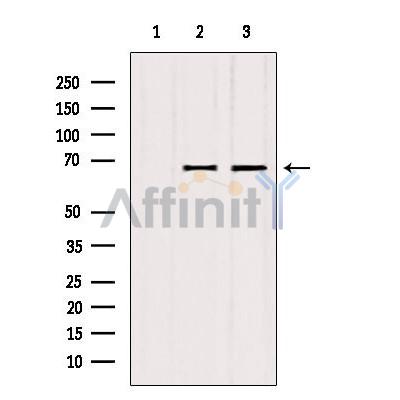ATP6V1A Antibody - #DF12353
| Product: | ATP6V1A Antibody |
| Catalog: | DF12353 |
| Description: | Rabbit polyclonal antibody to ATP6V1A |
| Application: | WB IHC |
| Reactivity: | Human, Mouse, Rat |
| Prediction: | Pig, Bovine, Horse, Sheep, Dog, Chicken, Xenopus |
| Mol.Wt.: | 68 kDa; 68kD(Calculated). |
| Uniprot: | P38606 |
| RRID: | AB_2845158 |
Related Downloads
Protocols
Product Info
*The optimal dilutions should be determined by the end user. For optimal experimental results, antibody reuse is not recommended.
*Tips:
WB: For western blot detection of denatured protein samples. IHC: For immunohistochemical detection of paraffin sections (IHC-p) or frozen sections (IHC-f) of tissue samples. IF/ICC: For immunofluorescence detection of cell samples. ELISA(peptide): For ELISA detection of antigenic peptide.
Cite Format: Affinity Biosciences Cat# DF12353, RRID:AB_2845158.
Fold/Unfold
70kDa subunit; ATP6A1; ATP6V1A; ATP6V1A1; ATPase H+ transporting lysosomal subunit A1; ATPase H+ transporting, lysosomal 70kDa V1 subunit A; H(+) transporting two sector ATPase subunit A; H+ transporting ATPase chain A vacuolar (VA68 type); HO68; OTTHUMP00000214746; V ATPase 69 kDa subunit 1; V ATPase A subunit 1; V ATPase subunit A 1; V-ATPase 69 kDa subunit; V-ATPase subunit A; V-type proton ATPase catalytic subunit A; VA68; Vacuolar ATP synthase catalytic subunit A ubiquitous isoform; Vacuolar ATPase isoform VA68; Vacuolar proton pump alpha subunit 1; Vacuolar proton pump subunit alpha; VATA_HUMAN; Vma1; VPP2;
Immunogens
A synthesized peptide derived from human ATP6V1A, corresponding to a region within C-terminal amino acids.
- P38606 VATA_HUMAN:
- Protein BLAST With
- NCBI/
- ExPASy/
- Uniprot
MDFSKLPKILDEDKESTFGYVHGVSGPVVTACDMAGAAMYELVRVGHSELVGEIIRLEGDMATIQVYEETSGVSVGDPVLRTGKPLSVELGPGIMGAIFDGIQRPLSDISSQTQSIYIPRGVNVSALSRDIKWDFTPCKNLRVGSHITGGDIYGIVSENSLIKHKIMLPPRNRGTVTYIAPPGNYDTSDVVLELEFEGVKEKFTMVQVWPVRQVRPVTEKLPANHPLLTGQRVLDALFPCVQGGTTAIPGAFGCGKTVISQSLSKYSNSDVIIYVGCGERGNEMSEVLRDFPELTMEVDGKVESIMKRTALVANTSNMPVAAREASIYTGITLSEYFRDMGYHVSMMADSTSRWAEALREISGRLAEMPADSGYPAYLGARLASFYERAGRVKCLGNPEREGSVSIVGAVSPPGGDFSDPVTSATLGIVQVFWGLDKKLAQRKHFPSVNWLISYSKYMRALDEYYDKHFTEFVPLRTKAKEILQEEEDLAEIVQLVGKASLAETDKITLEVAKLIKDDFLQQNGYTPYDRFCPFYKTVGMLSNMIAFYDMARRAVETTAQSDNKITWSIIREHMGDILYKLSSMKFKDPLKDGEAKIKSDYAQLLEDMQNAFRSLED
Predictions
Score>80(red) has high confidence and is suggested to be used for WB detection. *The prediction model is mainly based on the alignment of immunogen sequences, the results are for reference only, not as the basis of quality assurance.
High(score>80) Medium(80>score>50) Low(score<50) No confidence
Research Backgrounds
Catalytic subunit of the peripheral V1 complex of vacuolar ATPase. V-ATPase vacuolar ATPase is responsible for acidifying a variety of intracellular compartments in eukaryotic cells. In aerobic conditions, involved in intracellular iron homeostasis, thus triggering the activity of Fe(2+) prolyl hydroxylase (PHD) enzymes, and leading to HIF1A hydroxylation and subsequent proteasomal degradation. May play a role in neurite development and synaptic connectivity.
Cytoplasm.
High expression in the skin.
Belongs to the ATPase alpha/beta chains family.
Research Fields
· Cellular Processes > Transport and catabolism > Phagosome. (View pathway)
· Environmental Information Processing > Signal transduction > mTOR signaling pathway. (View pathway)
· Human Diseases > Infectious diseases: Bacterial > Vibrio cholerae infection.
· Human Diseases > Infectious diseases: Bacterial > Epithelial cell signaling in Helicobacter pylori infection.
· Human Diseases > Immune diseases > Rheumatoid arthritis.
· Metabolism > Energy metabolism > Oxidative phosphorylation.
· Metabolism > Global and overview maps > Metabolic pathways.
· Organismal Systems > Nervous system > Synaptic vesicle cycle.
· Organismal Systems > Excretory system > Collecting duct acid secretion.
Restrictive clause
Affinity Biosciences tests all products strictly. Citations are provided as a resource for additional applications that have not been validated by Affinity Biosciences. Please choose the appropriate format for each application and consult Materials and Methods sections for additional details about the use of any product in these publications.
For Research Use Only.
Not for use in diagnostic or therapeutic procedures. Not for resale. Not for distribution without written consent. Affinity Biosciences will not be held responsible for patent infringement or other violations that may occur with the use of our products. Affinity Biosciences, Affinity Biosciences Logo and all other trademarks are the property of Affinity Biosciences LTD.
